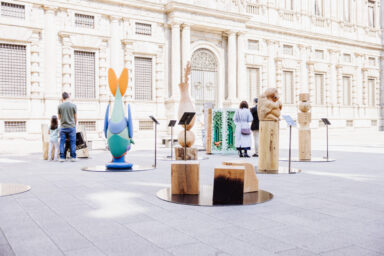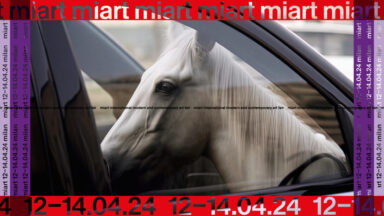Between pop art and South American culture, the Venezuelan artist Eduardo Sanabria EDO tells us the history of his country, a treasure full of natural beauties and resources but prisoner of political repression
Text by: Silvia Morales
An art of social criticism that, alongside the book “Historieta de Venezuela” just released with the journalist Laureano Marquez, traces the past of Venezuela from Columbus up to today’s dictatorship of Maduro, revealing historical moments ignored by many. His works, which led him to be exiled from his country, invite to reflect on complex civil issues while maintaining the liveliness of colors and the “vanity pop” of comic book style.
Silvia: Nowadays, all over the world, many journalists are persecuted for their ideas against the leading power and fear for their lives every day. What encouraged you to make such a risky book? Do you think that satire is an effective tool to urge social change?
Eduardo Sanabria EDO: Fortunately I didn’t receive direct threats but the publication I worked for was taken by a regime’s testaferro to manipulate it, so I decided to leave. Today moreover I am no longer allowed to return to Venezuela. Regarding this book, it is the first graphic novel that tells the story of the country from the arrival of Christopher Columbus to the present day. I think that comic is a useful way for people to understand why Venezuela has come this far. The intention is not only to be understood by those who lived these situations in person, but also by those who don’t really know about Venezuela. Especially by the very young, those under the age of 20, so that their parents and grandparents can explain it to them, since they were born just under Chavez’s dictatorship.
S: But there was a time in which the public opinion had great respect and admiration for Chavez, considering him as an enlightened politician who could really bring wellness to the country (we also remember that celebrities like Naomi Campbell had been to him). It has to be said also that Venezuela is very rich in natural resources, like oil, gold and diamond fields which lead recently the government to introduce a cryptocurrency, the petro, pegged to the price of a barrel of oil, that could finally free the state from the US dollar. So what happened so dramatic to change the feeling of the population? After all, Maduro has been pointed out by Chavez himself on the verge of death…
ES: Chavez was a populist leader with a great charisma and popularity, and was influenced by Fidel Castro, who was equally charismatic. Moreover at that time the oil’s price was very high so there were large income in the country and there were no economic problems. But with Chavez the expropriations of all the Venezuelan private enterprises began, from the largest to the smallest, which were then abandoned to themselves. Now nothing is produced in Venezuela, everything is imported, or rather, it should be imported. So Maduro inherited this heavy situation and had to keep a population under control, but not having Chavez’s charisma.
S: Your art is both pop and revelatory of the situation in Venezuela. What is your commitment as an artist to support the political and social condition of your country?
ES: To me art serves not only to excite, as pop art works do with a more international and fresh spirit, but also to change people’s lives. This is why I created a pop style, representing public figures, music and cinema celebrities, and at the same time a more generic one that deals with the issue of political criticism. So through art I can talk about the mistakes of my country. For example, in the re-imagining of Picasso’s Guernica, in which I re-proposed the manifesto of barbarism of the Spanish Civil War bringing it to current events of violence experienced in Venezuela during the protests that made two years ago 150 deaths hidden by the government. I also see that in Milan circulate the posters of Banksy depicting one of the boys of the protests in Caracas… As an artist, I felt I had to do something and I tried to make my contribution. Of the Guernica were also made small editions, whose sales have been donated to the Universidad Católica Andres Bello of Carcas to finance scholarships for students in need. And 10% of the proceeds of the works exposed in Milan will go to sending medicines to Venezuela. So thanks to art one can change both the perception of a country by telling a story that is not known, but also helping people in a practical sense.
S:What is your artistic technique?
ES: I do the sketch in pencil first, I scan it and I rework it with photoshop with colors, then I print it with the giclée technique on a German cotton paper. At the end I intervene by hand, so each edition is always different from the others.
S: In your works there are many Western references, including those to Picasso, and as many of classic art, such as to Michelangelo and Leonardo. But thinking in particular about murals as a tool for social criticism, South American artists like Rivera and Siqueiros come to mind. For us Westerners, instead, the “murals” were the frescoes in the Churches to tell religious stories. What exactly are your reference artists? Do you have any closer to the history of your country?
ES: I have followed the work of Picasso, particularly fascinated by his ability to evolve through different styles. In particular, my attention has been captured by Cubism’s techniques, and the use of different colors for people’s faces is my way of referring to the transformative power of this movement. I have always been interested in the issue of mass consumption and the way in which the concept of pop art, starting with Andy Warhol, has changed and equaled art itself on a social level. I also really like Basquiat and his aggressive way of reflecting the reality of the 80s in New York: I would have loved to live there at the time! Generally I have always been fascinated by the “art callejero” (street art). Frida Kahlo has impressed me a lot too, both in the way she makes her art so personal and intimate, and how she evolved as a pop icon without wanting or even thinking about it. The Frida that I depict is a bit more “friendly” than what she painted, this is called “otra interpretación”. And of course Rivera and Siqueros who have made their murals a political denunciation, something that I have timidly tried to do as well, for example with “Guernica” or with other larger works that have Venezuela as their central theme.
The most important thing for me in this kind of works is the presence of many people, many subjects that tell different stories and meanings, such as in the “Historieta de Venezuela” with all the presidents depicted on the background, or in the “Primer Desayuno” that although it isn’t a political manifesto tells the past of Venezuela through its typical food, which is no longer there because of the serious scarcity of food resources. I am also inspired by Zapata, a great graphic muralist and painter.
And I really admire Cruz-Diez, not only as a great artist but also as a person, since I had the opportunity to meet him. Today he is more than 90 years old and lives in Paris, and is one of the founders, together with Soto, of Venezuelan kinetic art and the last one left alive. In the kinetic work I dedicated to him in fact he interprets the last Jedi warrior as a reference to Star Wars. The art of Cruz-Diez has become a symbol of the Venezuelan diaspora: the whole floor of Caracas’ airport is one of his works, indeed being kinetic it is a little scary to walk on it as the steps are not so visible.
S: Reflecting on the characters from the world of art and entertainment that you put in your works, such as the Beatles, Marilyn Monroe, Joker… Do they also serve as a critical analysis of society? In part they seem to be the expression of an opulent and self-congratulatory civilization. Do you think they can be considered as modern “vanitas”?
ES: I think that everyone in life can point out people who have influenced and affected them. I am a fan of comics and I have always been fascinated by the bad guy, Joker in particular. And then of course I have studied the character of Picasso who was an incredible merchandiser for his time and that today would be the first to wear a sweatshirt with Guernica’s print to show it to everyone using all kinds of social media.
S: Despite the social denunciation manifested in your works, these never fall into grotesque images but always maintain a cheerful style. It can be said that this is somehow the vanity of your art…
ES: The assumption of my art is being pop, colorful and playful, even when it comes to carrying out a social criticism. In fact, I always think of creating works that I would hang on the walls of my house. So I would never do anything grotesque, bloody, or about death… it’s not my style.
Cover: Historieta de Venezuela, Eduardo Sanabria EDO, 2017, Hernandez Art Gallery


